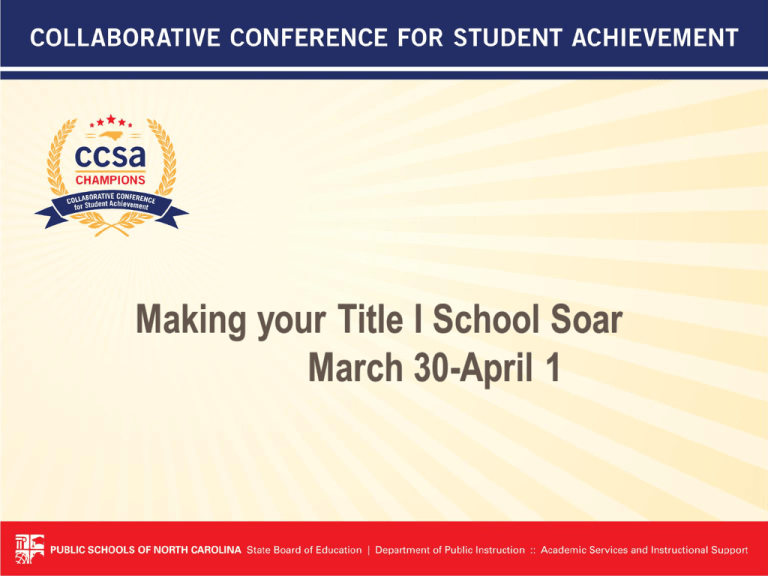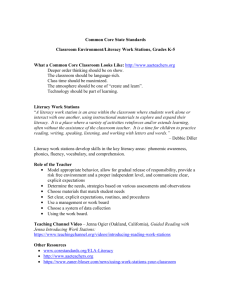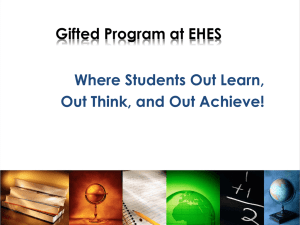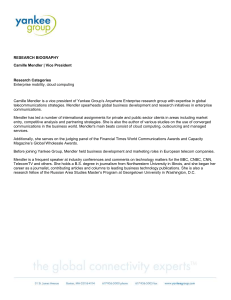Document 10823611
advertisement

Session Outcomes • Examine continuous improvement principles used in National Distinguished Title I Schools; and • Identify strategies you will consider implementing in your Title I School or district Attitude • Aim High • Set/share goals with stakeholders • Celebrate the successes Everything revolves around one’s attitude and the outstanding leaders of schools model this consistently” (Connors, 2000, If you don’t feed the teachers, they will eat the Students!) Blended Assessment Process • Formative Assessment • Benchmark Assessments • Summative Assessments “Formative assessment is a process used by teachers and students during instruction that provides feedback to adjust ongoing teaching and learning to improve intended instructional outcomes.” (CCSSO FAST SCASS, 2006) Coaching • • • • Principal as Instructional Leader Professional Learning Community Imbedded in Instructional Practices Teacher Leadership in action “The highest form of leadership development is coaching, because development and mentoring are critical to your success as well.” (Coble, Brubaker, 2005, The Hidden Leader) Data Usage/Decision Making • • • • Maintain data system school-wide PLC/Instructional Coach use data Principal share data school-wide Goal setting is generated from data Without the data, it is just another person’s opinion (unknown) Excellence is the Standard • Models of excellence posted in classrooms • Rubrics are provided to students • Students conduct self/peer assessments “Academic connection strategies offer many ways you encourage success in content areas. Students will not connect with school unless they believe that they can succeed” (Mendler, 2001, Connecting with Students) Process Activity Think/Pair/Share Family Nights • Reading Night: How to Read to your Child(ren) • Science/Social Studies/Technology • Community Reads Invite in Readers “ Leaders do whatever it takes to build a community where parents and other members truly feel invited into the building…..The goal is to provide a unified neighborhood within and outside of the school” (Connors, 2000, If you don’t feed the teachers, they will eat the students) Guided Reading • Release of Responsibility/Small Groups • Reading and Writing Connections • Use of technology, books and accountability system, specific advanced organizers Students do well with Graphic Organizers when teachers model, hold their hands and lead them to independence (Diller, 2003, Literacy Work Stations) Home School Relations • At home learning/Volunteer Program • Parent Resource Center/Lending Library • Parent Educator/Coordinator/Home Visits “Teachers can share information on different structures and monitoring techniques that parents can use to create conditions at home that match a child’s learning preferences” (Dean, Hubbell etc. 2002, Classroom Instruction that Works.) Instructional Leadership • • • • Conduct walk throughs/Instructional Rounds Identify Mentors/Beginning Teacher Support Use staff to provide on-going PD Formal evaluations (on time with feedback) “ A culture of shared leadership is so vital to principals, teachers and to the learning of youngsters” (Moller and Pankake, 2006, Lead with Me). Job Alike Meetings • Teacher Assistants/Exceptional Children • Special Areas (Music, Art, PE) • Grade Level Teams (PLC)/All staff monthly “Leaders who are willing to make the commitments of additional time and energy create outcomes that serve the organization and their own development as well.” (Brubaker & Coble, 2005, The Hidden Leader) Shoulder Partner Exercise Share an activity/event held in your school/district that supported shared leadership and made an impact on student academic progress in reading. Kindergarten Instruction/Process • Assess pre-reading skills/Generate an assessment process/Create a Portfolio • Use the data to generate an action plan • On-going teaching of pre-reading skills • “Kindergarten teachers add literacy work stations throughout the year as they introduce more print to students through reading aloud, shared reading, modeled writing, interactive writing and word wall lessons.” (Diller, 2003, Literacy Work Stations: Making Centers Work.) Lesson Plan • Failing to Plan is planning to fail • Use of a structure for Lesson Planning • Feedback from Leadership/PLC “PLC is to facilitate high levels of learning for all students by having teachers work collaboratively and engage in collective inquiry with colleagues” (Mendler, 2012, When Teaching Gets Touch Mentoring Programs Students • • • • Students need support/role models Support Social, Reading and Book Buddy Build Character/Academics Lunch Buddy/Weekly visits “Visit the cafeteria and eat lunch with a student who appears disconnected” (Mendler, 2001, Connecting with Students) Novice Teachers • • • • Mentor Support System On-going meetings with Principal/Directors Opportunity to visit other classrooms Resources/Individual and Group meetings “Few novice teachers have had master teachers who differentiated instruction are far more likely to do so in their first placement.” (Tomlinson, 1999, The Differentiated Classroom) On-going Data Review • • • • Student Portfolio/Share Writing Process Teacher/Principal Meeting (Report Card) Data Wall and Student Notebooks Goal Setting/Family Portfolio “ Formative and ongoing assessment enlightens and informs your day-to-day work with children” (Miller, 2008, Teaching with Intention) Parent Involvement • Parent Resource Center and Parents as Partners • Parent GED, ESL, ABE Classes • Parent Teacher Conferences “Communicating learning objectives to parents help them understand and become engaged in what their children are learning” (Dean, Hubbell etc. 2012, Classroom Instruction that Works) Three Minute Review • Go to the opposite side of the room; introduce yourself to someone and share a strategy you use in your Title I school or district. Quarterly Meetings • Review Data/Discuss next steps • Set goals/Articulation meetings • Team planning/Involve Special areas “Teaching teams whether grade level or subject support the core of collaboration, it is within these groups that teachers who share common students work together to focus on student learning.” (Moller and Pankake, 2006, Lead with Me) Resources • Seek annual needs’ assessment • Provide a variety of resources/training • Imbed resources in instruction including digital and print resources “The principal must secure resources and facilitate collective decision making that are aligned with the resources to support teaching and learning.” (Moller and Pankake, 2006, Lead with Me) Staff Development • • • • Annual PD Need’s Assessment Survey Analyze the data against training needs Summer Sessions/Morning trainings Teachers training teachers “Like great doctors, great teachers need continuous training to keep abreast of pedagogical methods and technology” (Mendler, 2012, When Teaching Gets Tough) Team Meetings • Hold weekly/Principal attends • Long and Short term Planning • Involve EC teachers/ Specialist/ Media “Learning plan format includes: What will students learn? And How will they show their learning?” (Reeves, 2011, Where Great Teaching Begins) Quick Write Based on your experience in this session, create a quick write you will share with a Title I school/district Uninterrupted Reading Block • 90 minute focus on Reading/Literacy • Flexible reading groups/Literacy Work Stations/Practice reading skills alone • Speech, Reading, Assistants, Special area teachers and Exceptional Children's teachers “The emphasis at literacy work stations is on practice, meaningful, independent practice.” (Miller, 2003, Literacy Work Stations) Visible Human Resources • Word Work/Tutoring students/Buddy • Conducting small groups/Reviewing Skills • Foster Grandparents/Book Buddies/Volunteers “In virtually every community there are a substantial number of people eager to volunteer their time and resources to support classrooms.” (Mendler, 2012, When Teaching Gets Tough) Writing Integration • DEAR time has Accountability; Community Supports • Use of Journals; Buddy Reading and Writing • Shared Writing lessons/Authentic Writing “ A wide variety of writing activities should be presented at the writing work station throughout the school year.” (Diller, 2003, Literacy Work Stations.) Xtra Time • Summer School Program/Field Trips • Integrated in all disciplines/Use of Non-fiction books/Grants • After school programs/Homework Help “Design homework assignments that clearly articulate the purpose and outcomes of the lesson. (Marzano, Pickering etc. 2001, Classroom Instruction that Works) Year Long Goals • • • • Identify and revise goals Conduct benchmark assessments Use data to make instructional decisions Support classrooms with resources During planning, a teacher should generate specific list of what students should know, understand and be able to do at the end of a unit.” (Tomlinson,1999, The Differentiated Classroom.) Zealous Efforts • Individualized instruction/Personal goal setting/Individualized reading bags • Take Home Book Bag program • Transition Program Grades 1 and 2 “Informal assessments, in which teachers ask students to tell them what they know or demonstrate their progress, should be occurring every day.” (Reeves, 2011, Where Great Teaching Begins) Exit Slip • On a posted note, jot down one take away you have received from today’s session. Write down one idea that will make an impact on your Title I School and allow it to Soar! Resources CCSSO, FAST, SCASS, 2006 Formative Assessment Coble, Brubaker, 2005, The Hidden Leader Connors, 2000, If you don’t feed the teachers, they will eat the Students Dean, Hubbell etc. 2012, Classroom Instruction that Works Diller, 2003, Literacy Work Stations: Making Centers Work.) Marzano, Pickering etc. 2001, Classroom Instruction that Works Mendler, 2001, Connecting with Students Mendler, 2012, When Teaching Gets Tough) Miller, 2008, Teaching with Intention) Resources Moller and Pankake, 2006, Lead with Me) Reeves, 2011, Where Great Teaching Begins) Tomlinson,1999, The Differentiated Classroom.) Contact Information Dr. Frances Harris-Burke Regional Lead NCDPI Frances.harrisburke@dpi.nc.gov 703-217-8170




